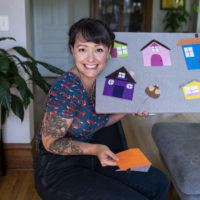Baby movement patterns – Crawling, Rolling, Walking
Babies from 3-6 months are capable of rolling and crawling, and we as parents find it very fantastic and amusing. Seeing your baby do these movements is fun and it is interesting to see how they are developing and discovering the forces of gravity.
In this interview, together with Beverly Strokes, we will learn about baby movements such as crawling, rolling, and walking. We will also learn about the proper ways to support and provide babies with the support they need to develop properly during the critical period from birth until independent walking.
Beverly Stokes, an international author, and baby movement specialist will talk about:
🔹 Why movement is so critical to future cognitive development
🔹 What are the developmental movement milestones?
🔹 Why bouncy seats/recliners can be harmful to development?
🔹 How to help your baby rollover
Full Interview Transcript
Kelly: Today we’re here with Beverly Stokes, an international author and baby movement specialist. In this interview, you will find out what to do if your baby wants to skip crawling and go straight to walking, and how to provide your baby with the stimulation they need to develop properly during the critical period from birth until independent walking.
Beverly, thank you so much for being here.
Beverly: I’m delighted to be here Kelly to talk about my work.
Kelly: What is a baby movement specialist?
Beverly: Developmental movement is the foundation of all human movement. For over 25 years, I have been coaching parents on their babies’ natural movement in the first year.
Kelly: Why would someone go to a baby movement specialist? Because I mean, don’t we all eventually learn how to walk? Why is it so important that they would need a specialist to tell them what they need to do?
Beverly: I think what’s really new in my work andwhatI really like parents to know is that babies are motivated to explore, and problem solve in the environment. They’re doing the movements, but when there’s a little toy around or something that they can interact with, they’ll explore for long periods of time. They’re learning, they’re exploring, and wanting to share their experience.
This enhances their learning and their cognitive development.
Kelly: Can you give us a baseline then at what age they’d be crawling or rolling over, then crawling, and walking? What are the baselines for a healthy development?
Beverly: In the first six months, which is really important, the babies are learning about gravity. They’re developing strength. They’re developing head and neck control. They’re doing this in four body positions: lying on their back, lying on their front, and lying on each side
The first pattern after six months is they push up both hands. Usually the baby is trying to go somewhere to get something, to go and see somebody. What happens is they’re pushing, and their body is sliding backwards. They’re sliding away from where they want to go. They usually find that quite funny, but it is a protective response.
The second pattern is the belly crawling pattern. That is a lateral pattern through one side of the body. We see that in the five-month-old baby when she pushes from the foot in to a reach to reach a toy, to touch the mother’s face, something like that. But at seven months, now they do this. It’s a reciprocal pattern on both sides of the body and is known as belly crawling.
Then, babies get up off on to their hands and knees. They raise their belly up and go on hands and knees. There, they push back to sitting, to independent sitting.
Parents aren’t really tuned in to that. They think they have to sit or prop the baby, but they don’t. They just have to allow the baby to do the movements. When the baby is up on their hands, and usually that’s very new for them. They push back to one side and go to sitting.
Now, the other interesting thing, if you have ever been around a baby who is sitting for the first time, they’re up there, and now, they have to reverse the sequence to go back down to their belly. That’s a lot of learning going on there.
After that, they go in to hands and knees creeping. Now, people sometimes call that crawling, but I usually call the one on the belly, belly crawling and the cross-lateral movement, hands and knees creeping, and that is with the reach of the hand, the diagonal connection through the body, and the pull of the leg and both sides of the body. For me, I always say creeping take several months to develop fully. A baby is up there, and it takes a while before it’s a simultaneous action.
Then, they go in to a staccato movement. They’re now increasing their timing. Then, they will take time to do a smoother action. All of this learning in cross-lateral creeping is taking over three months.
Kelly: I do hear a lot of moms worried, for example that they’re baby has skipped crawling, and they want to start walking? If your baby is wanting to walk, what are your suggestions?
Beverly: Something they can do is if there are stairs around, take the baby and the baby can climb up stairs, and that’s a cross-lateral movement, but it’s in a vertical direction. Parents can be playful. They can say, “Get down on the floor,” in their hands and knees and, “Come and creep after me like a cat,” so move like the animals. They can sit on the floor and extend their legs, and the baby can crawl and climb over them.
Kelly: Do you think that part of moving can be inhibited because the parents are maybe putting them in the bouncy chair or the walker? What do you think about that?
Beverly: I have written about it, about all the containers, the babies they’re put in, and what happens. But what I’m particularly concerned aboutnow are these bouncy seats because it seems like they’re in the bouncy seats for very long periods of time.
I talk about overuse, and what I mean by that, if it’s done for safety, that’s one thing. But to leave the baby there, now, what is the baby doing? The baby is reclined in a curve. The baby can’t rotate their head fully to either side. They can’t reach.
They also have their legs in this frog leg position. This is what they’re exploring for long periods of time. What they’re missing are the interactions with gravity and overcoming gravity.
The baby is developing in relationship to gravity, and they don’t get that experience if they’re not on the floor. That’s a good reason. In fact, what really interests me when babies are doing the movement, what else do they do?
I’d like to show you a couple of photographs in my book about a three-month-old baby. She’s lying on her back and you can see she’s raising both legs so she’s interacting with gravity. She is playing with a toy. NOTE: INSERT PHOTO #1 HERE
It’s quite large, but it’s very lightweight. Her visual attention is captured by the curve, and this is a baby whale, in the curve of the whale’s tail. [She recognizes that she can curve her own hand and put it in that space. That’s quite amazing. She adjusts it and even places it higher in the curve of the whale’s tail.
She’s recognizing shape, and she’s getting a lot of tactile information.
Kelly: What about rolling? If your baby is not rolling, I think you kind of touch on that a little bit, but what can a mom do if her baby’s not rolling?
Beverly: Yes. Well, rolling is a big thing for parents too. But rolling occurs, again, over several months. A three-month-old may just roll over to the side using just both legs going together, both arms going together.
Now, when they roll from their back to their front, that is a different movement. They need to probably reach over with one hand across the body. Now, what a parent could do is maybe roll the pelvis a little if the baby gets stuck and helps the baby roll over.
Another thing that’s really important, again,the parent can position herself or himself on either side. They can entice the baby with a toy. When they place the toy to the side, they have to be sure there’s enough space for the baby to roll. The other thing is for the baby’s visual attention to see the toy, not to place it too high because you want a baby to roll with head flexion and not spinal extension. That is important, and again, to entice the baby on both sides.
Now, at five and six months, babies’ rolling is much more differentiated. They’re separating their arms from each other, their legs from each other. Their head is coming up off the ground as they’re rolling. That’s covering three months that the rolling is integrated in different ways.
Kelly: They’re having their parent on the floor instead of just putting them in front of a mobile. You need to actually be on there to help them develop. If you have them on the floor by themselves, would they naturally.
Beverly: They might do some things. If their toys are around, they may explore toys. You can’t be sitting on the sofa and your baby is on the floor because for one thing, you can see your baby, but a very young baby can’t see you.
Kelly: Right.
Beverly: A baby knows when the parent is engaged. That is what is so important because things happen. The baby does different movements. They will play with a toy differently, and then, they’ll look up and look at the parent because they know that the parent is being totally engaged.
Beverly: It’s important for the parent to be spontaneous. When they’re down at the floor with the baby, they are observing what the baby is doing. If the baby wants to play–Five months old babies are really funny, and they play lots of games. One may be that they’re going to go over and touch your hand, and then look at you and see if you think that’s funny.
They stay in contact. Very young babies stay in contact maybe a foot against a parent’s body, maybe a hand. When a parent is there, their social engagement, the interactions, the fun, and play they can be doing with their baby is wonderful.
Kelly: It’s fascinating. I think people don’t realize all these little things. They think, “Oh, it’s just a baby,” but it’s such a huge time.
Beverly: It’s huge. I have had experience with one mom. She had a 10-month-old baby, and I visited her. I said, “Oh, are you having a wonderful time with your baby looking at you and vocalizing?” She said, “Well, my baby can’t see me yet.”
Kelly: She didn’t think that was important.
Beverly: She didn’t think that the baby’s vision had developed to the point where even in her arms. What I did was I actually had her stand up and hold her baby, and I videotaped her over the shoulder.
When the baby saw the camera, the baby looked at the camera and then looked at her face and smiled. She said, “Oh, he can see me.” I said, “Yes.” Well, now, can you imagine their relationship now and how she would interact differently with her baby?
Kelly: Well, I really appreciate you coming on and sharing. This is so important especially for parents because I don’t think people do realize how important it is.
Beverly: No.
Kelly: Where can they go to find more information about your research?
Beverly: I have a new website, beverlystokes.com. That is going to have information about the Amazing Babies Academy.
Kelly: Great. Thank you so much.
Beverly: You’re very welcome. It’s lovely to be here.

About Beverly Stokes
BEVERLY STOKES, CMA, RSME, is the founder and director of the Center for Experiential Learning established in 1985. A Certified Movement Analyst and registered Somatic Movement Educator, she is acknowledged as a leader in the field of baby movement development and nonverbal communication, having worked with babies and their families for more than 20 years. She leads workshops throughout the United States and Canada. For more information visit, www.BeverlyStokes.com




